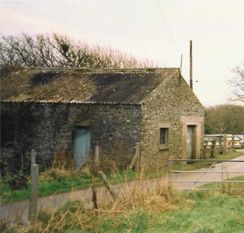|
Originally a corn grist mill, the
mill and woollen factory at Porth y Rhaw was owned and run by Mr Sylvester.
To
get maximum power from the stream, 3 leats were built further up the
valley. On commencing work for the day, the lowest leat would be
opened to increase stream flow. During the day as the leats run dry,
the next one higher up would be opened. At the end of the working day,
the miller closed all 3 leats so that they could refill during the
night. On his way home, he probably popped by his garden for some
vegetables. The millers terraced garden can be spotted on the east
valley side just below the present day pond. Once a year a sailing
boat would approach Porth-y-Rhaw to which the miller rowed out to pick
up his years supply of die. The mill stood for at least a hundred
years before it ceased working in about 1915.
The Pumping Station at Nine
WellsOn 10th June 1899, the St
David's Gas and Water Bill received the royal assent.
Within a
year, a steam pump was pumping water from the pumping station up
to the water tower near Llanruidion (located ½ mile along the road to St Davids on
the left) from where the water gravity fed St Davids and the
surrounding area.
The pumping station
was decommissioned during the 1970's after which the Rose Bush
reservoir in the Preseli Mountains took over the supply to St
Davids and the surrounding area.
The history of the pumping station
collated by Howard Jones May 2012
|

The Pumping Station in the 1980's
|
|

The Iron Age Fort at Porth-y-Rhaw
|
The Quarry
Half way down the track to the Mill
at Porth-y-Rhaw is a former quarry. Stone would have been transported
by pony and trap or horse and cart.
Iron Age Fort
The seaward side of the fort has
fallen hundreds of feet into the sea but the landlocked side shows
just how strong the defences were. The banks and troughs are clearly
visible after 2000 years. There would have been up to eight
roundhouses within the safety of the defences.
More information or
much more. (new window)
|
|